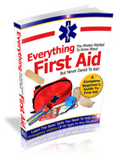Welcome to lacerations Guide
Ways To Make Lacerations Heal Faster Article
 To bookmark this article for further reading, click here.
To bookmark this article for further reading, click here.
Buckle Up to Prevent Facial Lacerations
Some of the worst injuries suffered in car crashes are those where the occupants were not wearing seatbelts. Deceleration injuries such as in motor vehicle accidents are very serious, and often fatal.
Survivors of car wrecks often suffer broken bones about the face and facial lacerations. Often nerve damage is a result of facial lacerations; it may take months for the nerves to repair.
Often the prognosis will not be known until severed nerves begin to regenerate.
Seatbelts can help to prevent facial lacerations, because the occupant is restrained from slamming into the windshield or other objects in the car, like the mirror, steering wheel or dashboard.
Buckling up is the law, yet many drivers and occupants don’t comply for one reason or another. Often occupants in the back seat don’t buckle their seatbelts, and in the event of a collision the person is thrown forward into the seat in front.
Not only they at risk for facial lacerations, they are a moving object themselves propelling into an occupant that may be in the front seat.
You might not want to wear your seatbelt. You might complain that the seatbelt doesn’t fit you properly.
Maybe you are larger than average size and the seatbelt won’t go around you. If you are not wearing a seatbelt for reasons that it doesn’t fit or is too tight, it is imperative that you purchase a seatbelt extender to safely harness you into your vehicle. Seatbelt extenders are not very expensive.
You can buy them to fit any seatbelt; there is no reason to put yourself or your loved ones at risk. Seatbelts save lives; they prevent all manner of serious injuries, including facial lacerations.
The scalp, eyebrow and cheek areas are often fractured, because they are the first to absorb the force of impact.
Broken bones and facial lacerations are most common when a driver or passenger is not properly restrained. Facial lacerations such as these bleed very rapidly because the face and scalp are very vascular. Many people die needlessly due to the shock of blood loss
Emergency trauma units are busy with the inflow of patients that were victims of car crashes. Some are lucky to survive, and others aren’t. Some of the survivors may have scarring that deforms the appearance of the face.
Facial lacerations are often jagged from the force of the impact; cosmetic reconstruction is often necessary. Plastic surgery can do wonders, but it hardly ever leaves a person as he/she was before the accident happened.
Sometimes nerve damage was so severe that the person’s facial sensation may be impaired or nonexistent.
Accidents happen all the time, but most bodily injury and facial lacerations can be avoided by just clicking your seatbelt. Many folks that have been in wrecks have walked away from the wreckage and thanked their lucky stars that they are alive.
By looking at some of the vehicles that have been totally demolished, they will admit that their seatbelt saved their lives.


